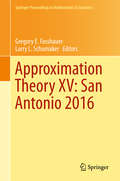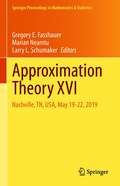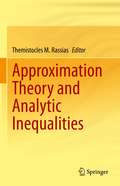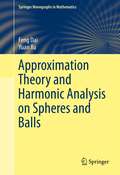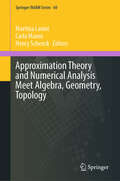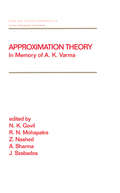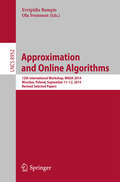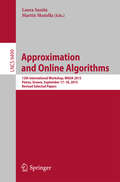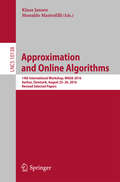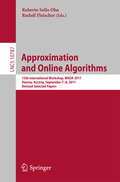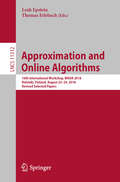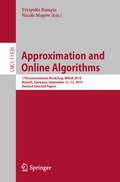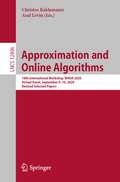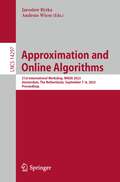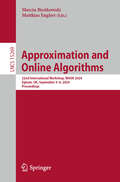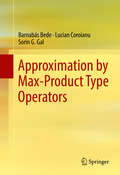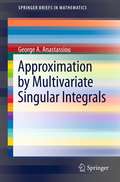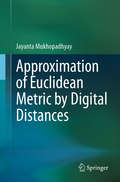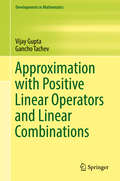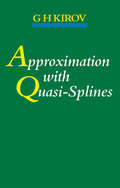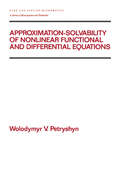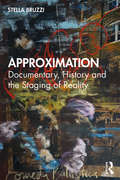- Table View
- List View
Approximation Theory XV: San Antonio 2016 (Springer Proceedings in Mathematics & Statistics #201)
by Gregory E. Fasshauer Larry L. SchumakerThese proceedings are based on papers presented at the international conference Approximation Theory XV, which was held May 22-25, 2016 in San Antonio, Texas. The conference was the fifteenth in a series of meetings in Approximation Theory held at various locations in the United States, and was attended by 146 participants. The book contains longer survey papers by some of the invited speakers covering topics such as compressive sensing, isogeometric analysis, and scaling limits of polynomials and entire functions of exponential type. The book also includes papers on a variety of current topics in Approximation Theory drawn from areas such as advances in kernel approximation with applications, approximation theory and algebraic geometry, multivariate splines for applications, practical function approximation, approximation of PDEs, wavelets and framelets with applications, approximation theory in signal processing, compressive sensing, rational interpolation, spline approximation in isogeometric analysis, approximation of fractional differential equations, numerical integration formulas, and trigonometric polynomial approximation.
Approximation Theory XVI: Nashville, TN, USA, May 19-22, 2019 (Springer Proceedings in Mathematics & Statistics #336)
by Gregory E. Fasshauer Larry L. Schumaker Marian NeamtuThese proceedings are based on the international conference Approximation Theory XVI held on May 19–22, 2019 in Nashville, Tennessee. The conference was the sixteenth in a series of meetings in Approximation Theory held at various locations in the United States. Over 130 mathematicians from 20 countries attended. The book contains two longer survey papers on nonstationary subdivision and Prony’s method, along with 11 research papers on a variety of topics in approximation theory, including Balian-Low theorems, butterfly spline interpolation, cubature rules, Hankel and Toeplitz matrices, phase retrieval, positive definite kernels, quasi-interpolation operators, stochastic collocation, the gradient conjecture, time-variant systems, and trivariate finite elements. The book should be of interest to mathematicians, engineers, and computer scientists working in approximation theory, computer-aided geometric design, numerical analysis, and related approximation areas.
Approximation Theory and Analytic Inequalities
by Themistocles M. RassiasThis contributed volume focuses on various important areas of mathematics in which approximation methods play an essential role. It features cutting-edge research on a wide spectrum of analytic inequalities with emphasis on differential and integral inequalities in the spirit of functional analysis, operator theory, nonlinear analysis, variational calculus, featuring a plethora of applications, making this work a valuable resource. The reader will be exposed to convexity theory, polynomial inequalities, extremal problems, prediction theory, fixed point theory for operators, PDEs, fractional integral inequalities, multidimensional numerical integration, Gauss–Jacobi and Hermite–Hadamard type inequalities, Hilbert-type inequalities, and Ulam’s stability of functional equations. Contributions have been written by eminent researchers, providing up-to-date information and several results which may be useful to a wide readership including graduate students and researchers working in mathematics, physics, economics, operational research, and their interconnections.
Approximation Theory and Harmonic Analysis on Spheres and Balls (Springer Monographs in Mathematics)
by Feng Dai Yuan XuThis monograph records progress in approximation theory and harmonic analysis on balls and spheres, and presents contemporary material that will be useful to analysts in this area. While the first part of the book contains mainstream material on the subject, the second and the third parts deal with more specialized topics, such as analysis in weight spaces with reflection invariant weight functions, and analysis on balls and simplexes. The last part of the book features several applications, including cubature formulas, distribution of points on the sphere, and the reconstruction algorithm in computerized tomography. This book is directed at researchers and advanced graduate students in analysis. Mathematicians who are familiar with Fourier analysis and harmonic analysis will understand many of the concepts that appear in this manuscript: spherical harmonics, the Hardy-Littlewood maximal function, the Marcinkiewicz multiplier theorem, the Riesz transform, and doubling weights are all familiar tools to researchers in this area.
Approximation Theory and Numerical Analysis Meet Algebra, Geometry, Topology (Springer INdAM Series #60)
by Carla Manni Martina Lanini Henry SchenckThe book, based on the INdAM Workshop "Approximation Theory and Numerical Analysis Meet Algebra, Geometry, Topology" provides a bridge between different communities of mathematicians who utilize splines in their work. Splines are mathematical objects which allow researchers in geometric modeling and approximation theory to tackle a wide variety of questions. Splines are interesting for both applied mathematicians, and also for those working in purely theoretical mathematical settings. This book contains contributions by researchers from different mathematical communities: on the applied side, those working in numerical analysis and approximation theory, and on the theoretical side, those working in GKM theory, equivariant cohomology and homological algebra.
Approximation Theory: In Memory of A.K. Varma (Chapman And Hall/crc Pure And Applied Mathematics Ser. #212)
by A. Sharma Z. Nashed N. K. Govil R. N. Mahapatra J. Szabados"Contains the contributions of 45 internationally distinguished mathematicians covering all areas of approximation theory-written in honor of the pioneering work of Arun K. Varma to the fields of interpolation and approximation of functions, including Birhoff interpolation and approximation by spline functions."
Approximation and Online Algorithms: 12th International Workshop, WAOA 2014, Wrocław, Poland, September 11-12, 2014, Revised Selected Papers (Lecture Notes in Computer Science #8952)
by Evripidis Bampis Ola SvenssonThis book constitutes the thoroughly refereed post-workshop proceedings of the 12th International Workshop on Approximation and Online Algorithms, WAOA 2014, held in Wrocław, Poland, in September 2014 as part of ALGO 2014. The 22 revised full papers presented were carefully reviewed and selected from 49 submissions. They cover a wide range of topics such as coloring and partitioning, competitive analysis, network design, packing and covering, paradigms for design and analysis of approximation and online algorithms, randomization techniques, real-world applications, and scheduling problems.
Approximation and Online Algorithms: 13th International Workshop, WAOA 2015, Patras, Greece, September 17-18, 2015. Revised Selected Papers (Lecture Notes in Computer Science #9499)
by Martin Skutella Laura SanitàThis book constitutes the thoroughly refereed post-workshop proceedings of the 13th International Workshop on Approximation and Online Algorithms, WAOA 2015, held in Patras, Greece, in September 2015 as part of ALGO 2015. The 17 revised full papers presented were carefully reviewed and selected from 40 submissions. Topics of interest for WAOA 2015 were: algorithmic game theory, algorithmic trading, coloring and partitioning, competitive analysis, computational advertising, computational finance, cuts and connectivity, geometric problems, graph algorithms, inapproximability, mechanism design, natural algorithms, network design, packing and covering, paradigms for the design and analysis of approximation and online algorithms, parameterized complexity, scheduling problems,and real-world applications.
Approximation and Online Algorithms: 14th International Workshop, WAOA 2016, Aarhus, Denmark, August 25–26, 2016, Revised Selected Papers (Lecture Notes in Computer Science #10138)
by Klaus Jansen Monaldo MastrolilliThis book constitutes the thoroughly refereed post workshop proceedings of the 8th International Workshop on Approximation and Online Algorithms, WAOA 2010, held in Liverpool, UK, in September 2010 as part of the ALGO 2010 conference event. The 23 revised full papers presented were carefully reviewed and selected from 58 submissions. The workshop covered areas such as algorithmic game theory, approximation classes, coloring and partitioning, competitive analysis, computational finance, cuts and connectivity, geometric problems, inapproximability results, echanism design, network design, packing and covering, paradigms for design and analysis of approximation and online algorithms, parameterized complexity, randomization techniques, real-world applications, and scheduling problems.
Approximation and Online Algorithms: 15th International Workshop, WAOA 2017, Vienna, Austria, September 7–8, 2017, Revised Selected Papers (Lecture Notes in Computer Science #10787)
by Rudolf Fleischer Roberto Solis-ObaThis book constitutes the thoroughly refereed workshop post-proceedings of the 15th International Workshop on Approximation and Online Algorithms, WAOA 2017, held in Vienna, Austria, in September 2017 as part of ALGO 2017.The 23 revised full papers presented in this book were carefully reviewed and selected from 50 submissions. Topics of interest for WAOA 2017 were: graph algorithms; inapproximability results; network design; packing and covering; paradigms for the design and analysis of approximation and online algorithms; parameterized complexity; scheduling problems; algorithmic game theory; coloring and partitioning; competitive analysis; computational advertising; computational finance; cuts and connectivity; geometric problems; mechanism design; resource augmentation; and real-world applications.
Approximation and Online Algorithms: 16th International Workshop, WAOA 2018, Helsinki, Finland, August 23-24, 2018, Revised Selected Papers (Lecture Notes in Computer Science #11312)
by Leah Epstein Thomas ErlebachThis book constitutes the thoroughly refereed workshop post-proceedings of the 16th International Workshop on Approximation and Online Algorithms, WAOA 2018, held in Helsinki, Finland, in August 2018 as part of ALGO 2018. The 19 revised full papers presented together with one invited paper in this book were carefully reviewed and selected from 44 submissions. Topics of interest for WAOA 2016 were: graph algorithms; inapproximability results; network design; packing and covering; paradigms for the design and analysis of approximation and online algorithms; parameterized complexity; scheduling problems; algorithmic game theory; algorithmic trading; coloring and partitioning; competitive analysis; computational advertising; computational finance; cuts and connectivity; geometric problems; mechanism design; resource augmentation; and real-world applications.
Approximation and Online Algorithms: 17th International Workshop, WAOA 2019, Munich, Germany, September 12–13, 2019, Revised Selected Papers (Lecture Notes in Computer Science #11926)
by Evripidis Bampis Nicole MegowThis book constitutes the thoroughly refereed workshop post-proceedings of the 17th International Workshop on Approximation and Online Algorithms, WAOA 2019, held in Munich, Germany, in September 2019 as part of ALGO 2019.The 16 revised full papers presented together with one invited paper in this book were carefully reviewed and selected from 38 submissions. Topics of interest for WAOA 2018 were: graph algorithms; inapproximability results; network design; packing and covering; paradigms for the design and analysis of approximation and online algorithms; parameterized complexity; scheduling problems; algorithmic game theory; algorithmic trading; coloring and partitioning; competitive analysis; computational advertising; computational finance; cuts and connectivity; geometric problems; mechanism design; resource augmentation; and real-world applications.
Approximation and Online Algorithms: 18th International Workshop, WAOA 2020, Virtual Event, September 9–10, 2020, Revised Selected Papers (Lecture Notes in Computer Science #12806)
by Christos Kaklamanis Asaf LevinThis book constitutes the thoroughly refereed workshop post-proceedings of the 18th International Workshop on Approximation and Online Algorithms, WAOA 2019, held virtually in September 2020 as part of ALGO 2020.The 15 revised full papers presented this book were carefully reviewed and selected from 40 submissions. Topics of interest for WAOA 2018 were graph algorithms, inapproximability results, network design, packing and covering, paradigms for the design and analysis of approximation and online algorithms, parameterized complexity, scheduling problems, algorithmic game theory, algorithmic trading, coloring and partitioning, competitive analysis, computational advertising, computational -finance, cuts and connectivity, geometric problems, mechanism design, resource augmentation, real-world applications.Chapter "Explorable Uncertainty in Scheduling with Non-Uniform Testing Times" is available open access under a Creative Commons Attribution 4.0 International License via link.springer.com.
Approximation and Online Algorithms: 21st International Workshop, WAOA 2023, Amsterdam, The Netherlands, September 7–8, 2023, Proceedings (Lecture Notes in Computer Science #14297)
by Andreas Wiese Jarosław ByrkaThis book constitutes the refereed proceedings of the 21st International Workshop on Approximation and Online Algorithms, WAOA 2023, held in Amsterdam, The Netherlands, during September 7–8, 2023The 16 full papers included in this book are carefully reviewed and selected from 43 submissions. The topics of WAOA 2023 were algorithmic game theory, algorithmic trading, coloring and partitioning, competitive analysis, computational advertising, computational finance, cuts and connectivity, FPT-approximation algorithms, geometric problems, graph algorithms, inapproximability results, mechanism design, network design, packing and covering, paradigms for the design and analysis of approximation and online algorithms, resource augmentation, and scheduling problems
Approximation and Online Algorithms: 22nd International Workshop, WAOA 2024, Egham, UK, September 5–6, 2024, Proceedings (Lecture Notes in Computer Science #15269)
by Marcin Bieńkowski Matthias EnglertThis book constitutes the refereed proceedings of the 22nd International Workshop on Approximation and Online Algorithms, WAOA 2024, held in Egham, UK, during September 5–6, 2024. The 15 full papers included in this book were carefully reviewed and selected from 47 submissions. They were organized in topical sections as follows: algorithmic game theory, algorithmic trading, coloring and partitioning, competitive analysis, computational advertising, computational finance, cuts and connectivity, FPT approximation algorithms, geometric problems, graph algorithms, inapproximability results, mechanism design, network design, packing and covering, paradigms for designing and analyzing approximation and online algorithms, resource augmentation, and scheduling problems.
Approximation and Online Algorithms: 4th International Workshop, Waoa 2006, Zurich, Switzerland, September 14-15, 2006, Revised Papers (Lecture Notes In Computer Science Ser. #4368)
by Christos Kaklamanis Asaf LevinThis book constitutes the thoroughly refereed workshop post-proceedings of the 18th International Workshop on Approximation and Online Algorithms, WAOA 2019, held virtually in September 2020 as part of ALGO 2020. <P><P> The 15 revised full papers presented this book were carefully reviewed and selected from 40 submissions. Topics of interest for WAOA 2018 were graph algorithms, inapproximability results, network design, packing and covering, paradigms for the design and analysis of approximation and online algorithms, parameterized complexity, scheduling problems, algorithmic game theory, algorithmic trading, coloring and partitioning, competitive analysis, computational advertising, computational -finance, cuts and connectivity, geometric problems, mechanism design, resource augmentation, real-world applications. Chapter "Explorable Uncertainty in Scheduling with Non-Uniform Testing Times" is available open access under a Creative Commons Attribution 4.0 International License via link.springer.com.
Approximation and Optimization: Algorithms, Complexity and Applications (Springer Optimization and Its Applications #145)
by Panos M. Pardalos Ioannis C. DemetriouThis book focuses on the development of approximation-related algorithms and their relevant applications. Individual contributions are written by leading experts and reflect emerging directions and connections in data approximation and optimization. Chapters discuss state of the art topics with highly relevant applications throughout science, engineering, technology and social sciences. Academics, researchers, data science practitioners, business analysts, social sciences investigators and graduate students will find the number of illustrations, applications, and examples provided useful. This volume is based on the conference Approximation and Optimization: Algorithms, Complexity, and Applications, which was held in the National and Kapodistrian University of Athens, Greece, June 29–30, 2017. The mix of survey and research content includes topics in approximations to discrete noisy data; binary sequences; design of networks and energy systems; fuzzy control; large scale optimization; noisy data; data-dependent approximation; networked control systems; machine learning ; optimal design; no free lunch theorem; non-linearly constrained optimization; spectroscopy.
Approximation by Max-Product Type Operators
by Sorin G. Gal Barnabás Bede Lucian CoroianuThis monograph presents a broad treatment of developments in an area of constructive approximation involving the so-called "max-product" type operators. The exposition highlights the max-product operators as those which allow one to obtain, in many cases, more valuable estimates than those obtained by classical approaches. The text considers a wide variety of operators which are studied for a number of interesting problems such as quantitative estimates, convergence, saturation results, localization, to name several. Additionally, the book discusses the perfect analogies between the probabilistic approaches of the classical Bernstein type operators and of the classical convolution operators (non-periodic and periodic cases), and the possibilistic approaches of the max-product variants of these operators. These approaches allow for two natural interpretations of the max-product Bernstein type operators and convolution type operators: firstly, as possibilistic expectations of some fuzzy variables, and secondly, as bases for the Feller type scheme in terms of the possibilistic integral. These approaches also offer new proofs for the uniform convergence based on a Chebyshev type inequality in the theory of possibility. Researchers in the fields of approximation of functions, signal theory, approximation of fuzzy numbers, image processing, and numerical analysis will find this book most beneficial. This book is also a good reference for graduates and postgraduates taking courses in approximation theory.
Approximation by Multivariate Singular Integrals (SpringerBriefs in Mathematics)
by George A. AnastassiouApproximation by Multivariate Singular Integrals is the first monograph to illustrate the approximation of multivariate singular integrals to the identity-unit operator. The basic approximation properties of the general multivariate singular integral operators is presented quantitatively, particularly special cases such as the multivariate Picard, Gauss-Weierstrass, Poisson-Cauchy and trigonometric singular integral operators are examined thoroughly. This book studies the rate of convergence of these operators to the unit operator as well as the related simultaneous approximation. The last chapter, which includes many examples, presents a related Korovkin type approximation theorem for functions of two variables. Relevant background information and motivation is included in this exposition, and as a result this book can be used as supplementary text for several advanced courses. The results presented apply to many areas of pure and applied mathematics, such a mathematical analysis, probability, statistics and partial differential equations. This book is appropriate for researchers and selected seminars at the graduate level.
Approximation of Euclidean Metric by Digital Distances
by Jayanta MukhopadhyayThis book discusses different types of distance functions defined in an n-D integral space for their usefulness in approximating the Euclidean metric. It discusses the properties of these distance functions and presents various kinds of error analysis in approximating Euclidean metrics. It also presents a historical perspective on efforts and motivation for approximating Euclidean metrics by digital distances from the mid-sixties of the previous century. The book also contains an in-depth presentation of recent progress, and new research problems in this area.
Approximation of Stochastic Invariant Manifolds: Stochastic Manifolds for Nonlinear SPDEs I (SpringerBriefs in Mathematics)
by Mickaël D. Chekroun Honghu Liu Shouhong WangThis first volume is concerned with the analytic derivation of explicit formulas for the leading-order Taylor approximations of (local) stochastic invariant manifolds associated with a broad class of nonlinear stochastic partial differential equations. These approximations take the form of Lyapunov-Perron integrals, which are further characterized in Volume II as pullback limits associated with some partially coupled backward-forward systems. This pullback characterization provides a useful interpretation of the corresponding approximating manifolds and leads to a simple framework that unifies some other approximation approaches in the literature. A self-contained survey is also included on the existence and attraction of one-parameter families of stochastic invariant manifolds, from the point of view of the theory of random dynamical systems.
Approximation with Positive Linear Operators and Linear Combinations (Developments in Mathematics #50)
by Vijay Gupta Gancho TachevThis book presents a systematic overview of approximation by linear combinations of positive linear operators, a useful tool used to increase the order of approximation. Fundamental and recent results from the past decade are described with their corresponding proofs. The volume consists of eight chapters that provide detailed insight into the representation of monomials of the operators Ln , direct and inverse estimates for a broad class of positive linear operators, and case studies involving finite and unbounded intervals of real and complex functions. Strong converse inequalities of Type A in terminology of Ditzian-Ivanov for linear combinations of Bernstein and Bernstein-Kantorovich operators and various Voronovskaja-type estimates for some linear combinations are analyzed and explained. Graduate students and researchers in approximation theory will find the list of open problems in approximation of linear combinations useful. The book serves as a reference for graduate and postgraduate courses as well as a basis for future study and development.
Approximation with Quasi-Splines
by G.H KirovIn the theory of splines, a function is approximated piece-wise by (usually cubic) polynomials. Quasi-splines is the natural extension of this, allowing us to use any useful class of functions adapted to the problem.Approximation with Quasi-Splines is a detailed account of this highly useful technique in numerical analysis.The book presents the requisite approximation theorems and optimization methods, developing a unified theory of one and several variables. The author applies his techniques to the evaluation of definite integrals (quadrature) and its many-variables generalization, which he calls "cubature."This book should be required reading for all practitioners of the methods of approximation, including researchers, teachers, and students in applied, numerical and computational mathematics.
Approximation-solvability of Nonlinear Functional and Differential Equations (Chapman And Hall/crc Pure And Applied Mathematics Ser. #171)
by Wolodymyr V. PetryshynThis reference/text develops a constructive theory of solvability on linear and nonlinear abstract and differential equations - involving A-proper operator equations in separable Banach spaces, and treats the problem of existence of a solution for equations involving pseudo-A-proper and weakly-A-proper mappings, and illustrates their applications.;Facilitating the understanding of the solvability of equations in infinite dimensional Banach space through finite dimensional appoximations, this book: offers an elementary introductions to the general theory of A-proper and pseudo-A-proper maps; develops the linear theory of A-proper maps; furnishes the best possible results for linear equations; establishes the existence of fixed points and eigenvalues for P-gamma-compact maps, including classical results; provides surjectivity theorems for pseudo-A-proper and weakly-A-proper mappings that unify and extend earlier results on monotone and accretive mappings; shows how Friedrichs' linear extension theory can be generalized to the extensions of densely defined nonlinear operators in a Hilbert space; presents the generalized topological degree theory for A-proper mappings; and applies abstract results to boundary value problems and to bifurcation and asymptotic bifurcation problems.;There are also over 900 display equations, and an appendix that contains basic theorems from real function theory and measure/integration theory.
Approximation: Documentary, History and the Staging of Reality
by Stella BruzziIn our era of ‘fake news’, Stella Bruzzi examines the dynamism that results from reusing and reconfiguring raw documentary data (documents, archive, news etc.) in creative ways. Through a series of individual case studies, this book offers an innovative framework for understanding how, in our century, film and media texts frequently represent reality and negotiate the instabilities of ‘truth’ by ‘approximating’ factual events rather than merely representing them, through juxtaposing disparate, often colliding, perspectives of history and factual events. Covering areas such as true crime, politics and media, the book analyses the fluidity and instability of truth, arguing that 'approximation' is more prevalent now in our digital age, and that its conception is a result of viewers’ accidental or unconscious connections and interventions. Original and thought-provoking, Approximation provides students and researchers of media, film and cultural studies a deeper insight into our understanding and acceptance of what truth really means today.
